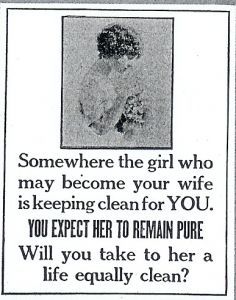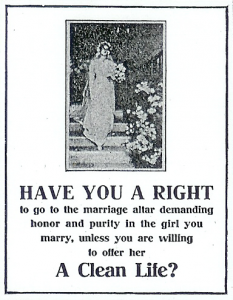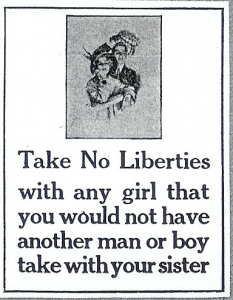As the lights dimmed in the local YMCA, a few last nervous giggles could be heard in the hall as a hush fell on the assembly of teenaged boys. The director switched on the projection “lantern” and the 50-slide show began. Though the program bore the title “Keeping Fit,” the boys had heard that it dealt with more than calisthenics and nutrition. It also spoke of sex.
 It was the 1920s, and the United States Public Health Service (USPHS) was fighting the devastating spread of venereal disease, much of it traceable to American soldiers returning from war in Europe. Of course, the USPHS sought cures and wider distribution of the treatments already available, but the agency was convinced that the education of as yet uninfected adolescents was crucial. So the government published a series of pamphlets and booklets to discourage promiscuity.
It was the 1920s, and the United States Public Health Service (USPHS) was fighting the devastating spread of venereal disease, much of it traceable to American soldiers returning from war in Europe. Of course, the USPHS sought cures and wider distribution of the treatments already available, but the agency was convinced that the education of as yet uninfected adolescents was crucial. So the government published a series of pamphlets and booklets to discourage promiscuity.
Unlike most sex education today, the material was ethical and even religious. Though the USPHS addressed medical issues (and even flirted with eugenics, talking about the vitality of the “stock”), they were not at all embarrassed to mention God and chastity and honor. While contemporary sex educators are all too eager to trumpet the “virtues” of “safe sex,” these 1920s writers urged “no sex until marriage.” It was a different time, but one well-worth admiring.
 Back to that slide show in the YMCA: The boys have seen slides on the importance of team sports and of labor at home (e.g., chopping wood and shoveling snow) and have read inspiring quotes from Robert E. Lee and Woodrow Wilson. But then the image of a bride appears, and they are asked whether they have the right to expect pre-marital celibacy from her when they are not themselves celibate.1 Though in the present era it seems quaint to speak this way, the government was not at all reluctant to talk of higher things when the topic was sex. Here are three themes common in the 1920s:
Back to that slide show in the YMCA: The boys have seen slides on the importance of team sports and of labor at home (e.g., chopping wood and shoveling snow) and have read inspiring quotes from Robert E. Lee and Woodrow Wilson. But then the image of a bride appears, and they are asked whether they have the right to expect pre-marital celibacy from her when they are not themselves celibate.1 Though in the present era it seems quaint to speak this way, the government was not at all reluctant to talk of higher things when the topic was sex. Here are three themes common in the 1920s:
 1. Purity: Another slide insisted that a man show the same regard for a woman that he would wish a stranger show for his sister.2 Such was the standard that Keeping Fit presented the youth, a standard expressed in the words “purity” and “keeping clean.”
1. Purity: Another slide insisted that a man show the same regard for a woman that he would wish a stranger show for his sister.2 Such was the standard that Keeping Fit presented the youth, a standard expressed in the words “purity” and “keeping clean.”
2. Sacredness: In those days, the government spoke freely of God, as in this “birds and bees” pamphlet for children. They had no problem with belief in “intelligent design”:
[U]nless God had given all living things this power to reproduce, plants and animals and men would long ago have disappeared from the earth. That is why we say this story is not only beautiful and wonderful; it is sacred. . . . When a man and woman love one another very much, and each thinks the other the dearest and most wonderful being in the world, they get married and live together. Then, if they have followed God’s laws, they may some day make their home happy with loving children.3
3. Nobility: Literature teachers were encouraged to lift up examples of sexual nobility (e.g., the chivalrous example of Ivanhoe) and draw out the lessons of negative examples (e.g., Reverend Dimmesdale’s adultery and cowardice in The Scarlet Letter).4
This was not the confusion of Church and State but the appropriation of pertinent truth to fight a national scourge. In those days, the government was not yet required by the courts to wear absurd moral and religious blinders,5 so agencies could speak more sanely of pure, sacred, and noble sexuality. And in reviewing this record, nostalgia may well give way to indignation as Americans consider what they have lost.
———————————–
Endnotes:
1 U.S. Public Health Service, Keeping Fit: An Exhibit for Older Boys and Young Men (Washington, DC: U.S. Government Printing Office, 1919), 10.
2 Ibid.
3 United States Public Health Service, The Wonderful Story of Life: A Parent’s Talks with Children Regarding Life and Its Reproduction (Washington, DC: United States Government Printing Office, 1940), 2-3, 16.
4 United States Public Health Service, High Schools and Sex Education: A Manual of Suggestions on Education Related to Sex, ed. Benjamin C. Gruenberg (Washington, DC: Government Printing Office, 1922), 72-79. The Project Gutenberg Website offers, for free, the complete texts of Ivanhoe (http://www.gutenberg.org/etext/82) and The Scarlet Letter (http://www.gutenberg.org/etext/33) (accessed March 20, 2008). Brief summaries are available, respectively, at Spark Notes Website (http://www.sparknotes.com/lit/ivanhoe/summary.html) and Cliffs Notes Website, (http://www.cliffsnotes.com/WileyCDA/LitNote/The-Scarlet-Letter-About-the-Novel-A-Brief-Synopsis.id-167,pageNum-5.html) (accessed March 20, 2008).
5 Blinders are patches sewn onto horses’ halters preventing them from looking to the right or left, forcing to look straight ahead. This is a metaphor for artificial restrictions on understanding.